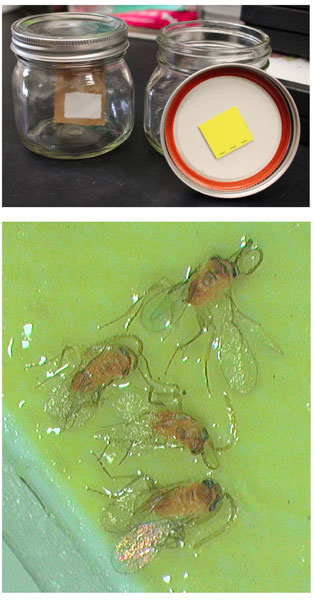5/1/2023
Eretmocerus eremicus: Parasitoid of Whiteflies
Raymond A. Cloyd

Eretmocerus eremicus is a parasitoid of the greenhouse (Trialeurodes vaporariorum) and sweetpotato whitefly (Bemisia tabaci). E. eremicus is widely used by greenhouse producers in the U.S. and Canada to manage whitefly populations on ornamental and vegetable crops. This article discusses the biology and behavior, commercial availability, and quality assessment of E. eremicus.
Biology & behavior
E. eremicus adults are 0.5 to 0.75 mm long. Females are yellow, have green compound eyes, three red spots on the head (Figure 1) and clubbed antennae. Males are yellow-brown and have elbowed antennae. The female-to-male ratio is almost 1:1 (60% females and 40% males).
Before laying an egg, a female uses her antennae to probe a whitefly nymph to assess suitability for development of a larva. Females lay (deposit) a single egg between the underside of a whitefly nymph (larva) and leaf surface. Females have an easier time laying eggs underneath whitefly nymphs on plant leaves with hairs (trichomes) than on smooth plant leaves. In addition, females prefer laying eggs underneath 2nd and 3rd instar whitefly nymphs.
Figure 1. E. eremicus adult female.
Figure 2. Whitefly pupae parasitized by E. eremicus.
Figure 3. Release card con-taining E. eremicus inside parasitized whiteflies.
A single female can lay between 50 and 200 eggs during her lifespan. A larva emerges (ecloses) from an egg after approximately four days. The larva then attaches to the underside of a whitefly nymph and chews a hole that allows entry into the body cavity of the whitefly nymph. The larva enters the whitefly and is inactive until the whitefly pupates. When the whitefly reaches the pupal stage, the larva releases digestive enzymes that liquefy the internal body contents, which allows the larva to more easily ingest the internal body contents of the whitefly. There are three larval instars. Whitefly pupae parasitized by E. eremicus are light-gray (Figure 2) to yellow-brown, whereas non-parasitized whitefly pupae are white or yellow.
An adult parasitoid can be seen through the cuticle (skin) of the dead whitefly pupa (fourth instar nymph) before emergence. The adult parasitoid chews a circular opening through the top portion of a dead whitefly pupa, which allows the adult to emerge.
Development time of the life cycle (egg to adult) is dependent on temperature. For example, the life cycle is completed in 17 to 18 days at 74F (23C) and 48 days at 63F (17C). The optimal temperatures for development and egg production are between 77 and 84F (25 and 29C). E. eremicus adults can tolerate temperatures 104F (>40C).
Adult females live about 14 days at 68F (20C) and 20 days at 75F (24C). However, not only does adult longevity depend on temperature, but also on food availability. Adults feed on honeydew, which is a clear sticky liquid produced by whiteflies. In addition, E. eremicus females feed on whitefly nymphs, which is necessary for egg production, resulting in death of the nymphs. In fact, a single female can kill up to 30 whitefly nymphs per day. Moreover, females can kill whitefly nymphs by creating wounds when repeatedly probing with their ovipositors (egg-laying devices). Females feed on the blood (hemolymph) that exudes from the wounds.
Commercial availability
E. eremicus is commercially available from most suppliers of biological control agents as release cards (Figure 3) containing parasitized whiteflies in which adults will emerge. Remove yellow sticky cards used to monitor whitefly adult populations before placing release cards within a crop to prevent capturing E. eremicus adults. Two weeks after placing the release cards within a crop, replace yellow sticky cards. Place release cards on the lower leaves of plants to reduce exposure to sunlight. Do not get the release cards wet when watering plants.

Quality assessment
To determine the quality of product received from suppliers, follow the procedures below to verify that E. eremicus adults are emerging from release cards.
1) Place a single release card into a glass Mason jar and attach a yellow sticky square 1.0 x 1.0 in. (2.5 x 2.5 cm) onto the underside of the lid using double-sided sticky foam (Figure 4).
2) Record the number of E. eremicus adults captured on the yellow sticky card square (Figure 5) after four, seven and 10 days.
3) Count and record the number of parasitized whitefly pupae per release card. Divide the number of E. eremicus adults captured on the yellow sticky square by the total number of parasitized whitefly pupae per release card. Multiply by 100 to obtain percent emergence of E. eremicus adults. Percent emergence of E. eremicus adults from the release cards should be greater than 80%.
Figure 4. Quality assessment of release card with E. eremicus.
Figure 5. Release card containing E. eremicus inside parasitized whiteflies.
E. eremicus has been effectively used by greenhouse producers to manage whitefly populations in various cropping systems. For example, we’ve been solely using E. eremicus to manage whitefly populations on poinsettia crops in a commercial greenhouse operations for two years (2021 and 2022) with minimal input from insecticide applications. GT
Raymond A. Cloyd is Professor and Extension Specialist in Horticultural Entomology/Plant Protection at Kansas State University in Manhattan, Kansas. He can be reached at (785) 532-4750 or rcloyd@ksu.edu.